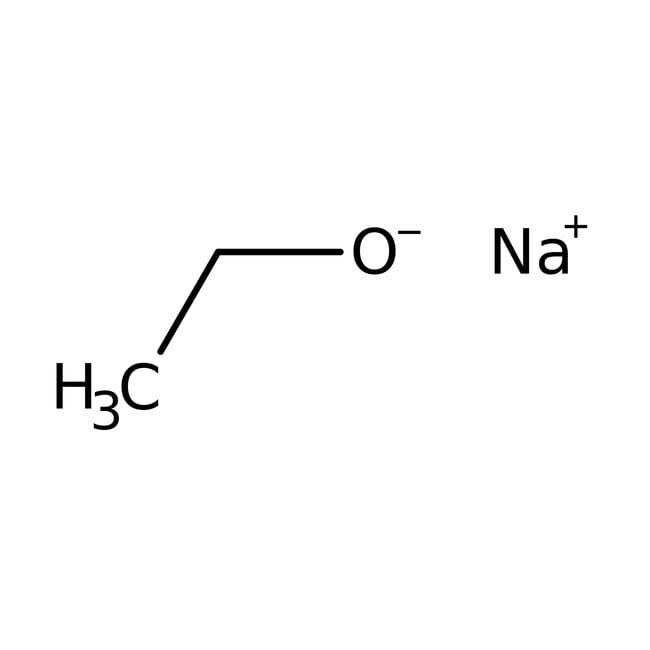Search Thermo Fisher Scientific
Thermo Scientific Chemicals
Sodium ethoxide, 96%, Thermo Scientific Chemicals
Catalog number L06230.0P
also known as L06230-0P
Price (USD)/ Each
241.65
Online exclusive
268.00 Save 26.35 (10%)
-
Quantity:
2000 g
Price (USD)/ Each
241.65
Online exclusive
268.00 Save 26.35 (10%)
Sodium ethoxide, 96%, Thermo Scientific Chemicals
Catalog numberL06230.0P
Price (USD)/ Each
241.65
Online exclusive
268.00 Save 26.35 (10%)
-
Chemical Identifiers
CAS141-52-6
IUPAC Namesodium ethanolate
Molecular FormulaC2H5NaO
InChI KeyQDRKDTQENPPHOJ-UHFFFAOYSA-N
SMILES[Na+].CC[O-]
View more
Specifications Specification Sheet
Specification Sheet
Appearance (Color)White to cream or pale yellow to yellow or pale orange
FormPowder
Assay (unspecified)≥95.0% (NaOC2H5)
Assay (Aqueous acid-base Titration)≥95.0 to ≤105.0% (total NaOC2H5)
Identification (FTIR)Conforms
View more
Sodium ethoxide is used as a strong base in organic synthesis. It is actively involved in the Claisen condensation, Stobbe reaction and Wolf-kishner reduction. It is an important starting material for the synthesis of ethyl ester and diethyl ester of malonic acid. In Williamson ether synthesis, it reacts with ethyl bromide to form diethyl ether. It is widely used as a base for the generation of carbanions which are utilized for alkylation and condensation reactions.
This Thermo Scientific Chemicals brand product was originally part of the Alfa Aesar product portfolio. Some documentation and label information may refer to the legacy brand. The original Alfa Aesar product / item code or SKU reference has not changed as a part of the brand transition to Thermo Scientific Chemicals.
Applications
Sodium ethoxide is used as a strong base in organic synthesis. It is actively involved in the Claisen condensation, Stobbe reaction and Wolf-kishner reduction. It is an important starting material for the synthesis of ethyl ester and diethyl ester of malonic acid. In Williamson ether synthesis, it reacts with ethyl bromide to form diethyl ether. It is widely used as a base for the generation of carbanions which are utilized for alkylation and condensation reactions.
Solubility
Soluble in ethanol and methanol.
Notes
Moisture sensitive. It undergoes hydrolysis rapidly to form sodium hydroxide in the presence of moist air. Incompatible with water, strong bases, acids, oxidizing agents, alkali metals, strong oxidizing agents, ammonia, acid chlorides, acid anhydrides, reducing agents, peroxides, acids and chlorinated solvents.
Sodium ethoxide is used as a strong base in organic synthesis. It is actively involved in the Claisen condensation, Stobbe reaction and Wolf-kishner reduction. It is an important starting material for the synthesis of ethyl ester and diethyl ester of malonic acid. In Williamson ether synthesis, it reacts with ethyl bromide to form diethyl ether. It is widely used as a base for the generation of carbanions which are utilized for alkylation and condensation reactions.
Solubility
Soluble in ethanol and methanol.
Notes
Moisture sensitive. It undergoes hydrolysis rapidly to form sodium hydroxide in the presence of moist air. Incompatible with water, strong bases, acids, oxidizing agents, alkali metals, strong oxidizing agents, ammonia, acid chlorides, acid anhydrides, reducing agents, peroxides, acids and chlorinated solvents.
RUO – Research Use Only
General References:
- In reactions where the presence of excess ethanol is undesirable, the use of pre-formed solid sodium ethoxide is much more convenient and safer than preparation in situ from sodium metal. This applies to many literature condensation reactions which employ powdered sodium in, for example ether or toluene, where the difficulty and hazards of obtaining a satisfactory sodium dispersion can be considerable. Solid sodium ethoxide often gives superior results, with better control of exothermic reactions.
- Extensively used as a base for the generation of carbanions in a variety of alkylation and condensation reactions. Organic Syntheses examples of the use of solid sodium ethoxide include:
- Condensation of acetone with ethyl acetate: Org. Synth. Coll., 3, 17 (1955). Benzoylation of acetophenone with ethyl benzoate: Org. Synth. Coll., 3, 251 (1955). ɑ-Formylations with ethyl formate: Org. Synth. Coll., 3, 300 (1955); 4, 536 (1963). ɑ-Ethoxalylation of diethyl succinate with diethyl oxalate: Org. Synth. Coll., 5, 687 (1973).
- Sanchez, B. S.; Benitez, B.; Querini, C. A.; Mendow, G. Transesterification of sunflower oil with ethanol using sodium ethoxide as catalyst. Effect of the reaction conditions. Fuel Process. Technol. 2015, 131, 29-35.
- Lyth, S. M.; Shao, H.; Liu, J.; Sasaki, K.; Akiba, E. Hydrogen adsorption on graphene foam synthesized by combustion of sodium ethoxide. Int. J. Hydrogen Energy 2014, 39 (1), 376-380.

